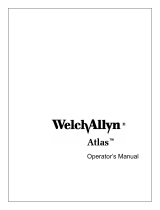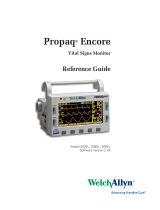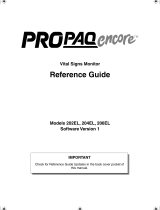A&D TM-2564GP User manual
- Category
- Measuring, testing & control
- Type
- User manual
This manual is also suitable for

TM-2560G / TM-2564G
T
M-2560GP / TM-2564GP
VITAL SENSOR
GRAPHIC MODEL
INSTRUCTION MANUAL
WM+PD4000753

© 2004 A&D Company Ltd. All rights reserved.
No part of this publication may be reproduced, transmitted, transcribed, or translated
into any language in any form by any means without the written permission of A&D
Company Ltd.
The contents of this manual and the specifications of the instrument covered by this
manual are subject to change for improvement without notice.

i
Compliance
Compliance with FCC Rules
This device complies with Part 15 of the FCC Rules. Operation is subject to the following two
conditions: (1) This device may not cause harmful interference, and (2) this device must accept any
interference received, including interference that may cause undesired operation.
(FCC = Federal Communications Commission in the U.S.A.)
Compliance with European Directive 93/42 EEC for Medical Products
This device conforms to European Directive 93/42 EEC for Medical Products. This is evidenced by
the CE mark of conformity accompanied by the reference number of a designated authority.
Warning Definitions
The warnings described in this manual have the following meanings:
Warning
Disregarding the warning could result in bodily injury or damage to the instrument.
Caution
Disregarding the caution could result in loss of important user data or damage to the
instrument.
Note
Provides information useful for the user to operate the instrument.
In addition to these shown above, there are more precautions specific to each section. Read the manual
carefully and observe the precautions.

ii
General Precautions
To handle the instrument properly and safely, read the instruction manual thoroughly and be fully
knowledgeable about the instrument before use.
The following are general precautions on handling the instrument safely and safety of patients and
operators. Precautions specific to the instrument will appear in the relevant pages.
The following points should be considered when you install or store the instrument.
Install or store the instrument away from moisture.
Install or store the instrument in an environment where the instrument is not badly affected by
extreme temperature, humidity, atmospheric pressure, direct sunlight, draft, dust, salinity or sulfur
content in the air.
Install or store the instrument in a secure and stable location.
Do not install or store the instrument where chemicals, and corrosive or explosive gases are stored
or present.
Install the instrument where a 3-pin electrical outlet adequate to the instrument is provided.
This instrument is not of the explosion-proof type. Do not use the instrument where flammable
materials, such as a flammable anesthetic, are used.
The following points should be considered before use
Check to make sure the instrument operates safely and accurately.
Check all hoses and cables for proper connection and deterioration.
When the instrument is used in combination with other instruments, pay extra attention to avoid
mis-diagnosis or other problems especially leakage current. Check all connections to make sure
they do not interfere with each other.
When other telemeters are used, check that mutual interference will not cause a problem.
When the instrument is operated using batteries, check that the specified batteries are used and
they are installed properly and in good conditions.
Use the AC adapter provided with the instrument.
Use the specified sensors.
The following points should be considered during use.
The instrument should be used only during the time required for diagnosis and medical treatment.
Check the patient and the instrument during use.
If medical or operational problems are found in the instrument or the patient, stop using the
instrument immediately, check the status of the patient and take proper actions.
Do not allow a patient to touch or operate the instrument.
Do not use the instrument where strong magnetic or electrical field exists.
Do not use the instrument on a patient using a heart-lung machine.

iii
High frequency interference by electrosurgery or energy discharged by a defibrillator may damage
the instrument. Follow the precautions described in the manual for each device.
(The instrument is protected against the energy discharged by a defibrillator only when the
accessory ECG extension cable is used.)
During electrosurgery, do not connect the ECG electrodes to the patient. (They may cause the
patient to be burned.)
Do not use a cellular telephone near the instrument. It could affect the instrument's operation.
The following points should be considered after use.
Follow a predetermined procedure to return the operation switches to their original positions, and
then turn off the power.
Do not forcibly pull out the cables and hoses.
Keep the instrument clean and in proper operating condition so that it can be used without problem
during the next operation.
Clean the accessories and arrange them before storage.
Perform the following when the instrument malfunctions.
Secure the patient’s or operator's safety.
Turn the power off and disconnect the power cable from the outlet.
Affix a notice such as “Out of Order” and “Do Not Use” on the device. Ask the nearest dealer for
services.
Do not disassemble or modify the device.
Perform regular maintenance and inspection of the instrument.
This is a precision instrument. Please check all functions and cables periodically.
If the instrument is used for the first time after an extended period of storage, check it for proper
operation.
Use a soft, dry cloth for removing stains from the instrument. Do not use solvents such as thinner or
benzine.
Strong electromagnetic waves may affect the instrument performance.
When the instrument is used near a strong electromagnetic field, it may malfunction and noises occur
in the waveform. If the instrument malfunctions unpredictably, check the environment for
electromagnetic fields and take adequate measures.
The following are typical causes of electromagnetic fields and measures against them.
Cellular telephones
Electric waves transmitted by a cellular telephone can cause the instrument to malfunction.
Turn off cellular telephones and other radio devices in medical facilities.

iv
High-frequency noises from other devices through the electrical outlet
Locates the noise source and eliminate its route using adequate measures such as a noise
elimination device.
Turn off the device that serves as a noise source, if possible.
Use another electrical outlet.
Static electricity discharged by the instrument or the environment
Discharge static electricity fully from the operator and the patient before use.
Humidify the room.
Lightening
Lightening occurring nearby may induce great amount of voltage to the instrument. Under such a
condition, operate the instrument as follows:
Disconnect the power cable from the electrical outlet and use the battery.
Use the uninterruptible power system that complies with IEC60601-1.
When using the instrument cause noise to the receiver such as a TV or radio, locate those
receivers away from the instrument.
Environmental protection
Remove the built-in lithium battery from the instrument when the instrument is to be disposed of.

v
Safety Precautions
The following are the cautions on measurements and sensors.
Blood pressure measurement
Blood pressure may not be measured when noise, such as consecutive irregular heart
rhythm and physical movement, is present. Check the reliability of the measured value
by displaying or printing the pulse graph.
The instrument takes preventive measures against artifact and shock. However, if you
have some doubts about the measured values, check the blood pressure by other
methods.
Position the cuff at the same height as the patients heart. Otherwise, a measurement
error may occur.
Use the cuff appropriate to the patient's arm circumference. Otherwise, a measurement
error may occur.
The maximum length of the hose is 3.5 (2 m + 1.5 m) meters long. Using a longer hose
may lower the amplitude level of the detected pulse and affect the measurement.
Do not use a twisted or tangled hose as it is. The air may be trapped in the cuff and
cause peripheral circulation disorder by stopping the blood circulation in the arm.
Measuring the blood pressure may cause minor hemorrhaging beneath the skin. The
hemorrhage is temporary and disappears with time.
Do not attach the cuff on a scar. The scar may worsen and cause infection.
Do not attach the cuff on an arm where intravenous drip or blood transfusion is
performed.
Cuff
The cuff contains dry natural rubber.
Natural rubber can cause allergic reactions such as itching, redness, hives, swelling,
fever, breathing difficulty, asthmatic reactions, blood pressure drop and shock. If the
patient exhibits such a symptom, stop using the instrument immediately and seek
medical treatment.
Warning
Warning

vi
Heart rate/pulse rate measurement
Monitor a patient using a pacemaker closely while measuring the heart rate.
Do not diagnose arrhythmia other than bradycardia or tachycardia by using the pulse
rate displayed and detected by the instrument.
The instrument employs three types of heart rate/pulse rate detection methods.
Heart rate by QRS detection from the ECG waveform (Only for models with ECG)
(The value is displayed in green.)
Pulse rate by arterial oxygen saturation (SpO
2
) measurement
(The value is displayed in blue.)
Pulse rate by blood pressure measurement
(The value is displayed in yellow.)
Transcutaneous arterial oxygen saturation measurement
Correct measurements may not be performed in the following cases:
• When pigment is introduced into the blood vessel
• When nails are coated with nail polish
• When physical movement is present
• When the sensor is firmly tightened.
• When carboxyhemoglobin and/or methemoglobin concentration cannot be ignored.
• During electrosurgery
• During CPR
• When measured on the body part where venous pulsations exist
• When the pulse wave is small
• When the patient has low perfusion
• When the sensor temperature is out of the range of 28°C to 42°C.
When not in use, disconnect the cable from the instrument. Noise may enter an unused
sensor, causing an erroneous display.
Always monitor the SpO
2
plethysmograph and pulse wave bar graph to check against
bad blood circulation.
Excessive light may cause inaccurate measurements. In such cases, cover the sensor
with an opaque material.
Use the specified SpO
2
sensor for accurate measurement.
If the sensor is wrapped too tightly or supplemental tape is applied, venous pulsations
may lead to inaccurate saturation measurements.
Warning
Caution
Warning

vii
SpO
2
sensor
Use a Nellcor sensor listed in the following table.
Type Disposable Reusable
Model OXISENSOR OXIBAND
Parts # MAX A MAX AL MAX P MAX I MAX N MAX R DURA-Y DS100A RS10 OXI-A/N OXI-P/1
Compatibility Yes Yes Yes Yes No Yes Yes Yes No Yes Yes
Read the instruction manual supplied for the sensor carefully before use.
Finger clip type sensor
• Use only for adult fingers. Do not use the sensor on other body parts.
• For short term monitoring. If the sensor is to be used for 4 hours or longer, alternate
fingers used. For extended monitoring, use a flex type sensor.
• Do not affix the sensor to the finger with tape. This may cause congestion or edema,
resulting in skin damage.
• When cleaning the sensor, clean with a cloth moistened with 70% alcohol or other
disinfectant.
Flex type / Disposable sensor
• Though the sensor is suitable for long term monitoring, check the skin and sensor
mount at fixed intervals (every 8 hours). If a change or discoloration in skin is detected,
move the sensor to another area.
• If strong light affects the sensor, cover it with an opaque material.
• When securing the sensor with tape, avoid tightening too strongly to prevent
congestion and edema.
• If the patients exhibit allergic reactions to the adhesive tape, stop using the sensor.
Care must be taken while peeling off adhesive tape.
The temperature on the body part where the SpO
2
sensor is attached rises by 2°C to
3°C, that may cause compression necrosis or burns. If the patient has a fever or suffers
from peripheral circulation disorder, change the sensor site frequently.
The disposable sensor is sterilized for single use on a single patient. Do not re-use it
on another patient.
Refer to the manual of each sensor for details.
Warning
Note
Caution

viii
Unpacking / Inspection
Caution
This is a precision instrument. Handle it with care. Strong shock may cause failure.
Note
This instrument is delivered in a packing box designed to prevent damage during normal
transportation. When unpacking the instrument, check it for damage. If your instrument has been
damaged, contact the agent you purchased it from. Retain the packing materials, which are required to
transport this instrument.
Check that the following articles are included when you unpack the instrument.
TM-2560G TM-2564G TM-2560GP TM-2564GP
Main unit
Instruction manual
Adult cuff with 2-meter hose
1.5-meter hose
SpO
2
extension cable
ECG extension cable
ECG patient cable
AC adapter
Power cable
Printer paper (white) 5 rolls
Printer paper (graph) 2 rolls
SpO
2
sensor pack
(with instruction manual)
Battery
= Available

ix

1
Contents
Compliance.................................................................................................................................................i
Warning Definitions...................................................................................................................................i
General Precautions.................................................................................................................................ii
Safety Precautions....................................................................................................................................v
Unpacking / Inspection..........................................................................................................................viii
1. Introduction...........................................................................................................................................3
1-1 Features......................................................................................................................................................3
2. Specifications........................................................................................................................................4
2-1 Models.........................................................................................................................................................4
2-2 Main Unit.....................................................................................................................................................4
2-3 Measurement ..............................................................................................................................................5
3. Part Names............................................................................................................................................6
3-1 TM-2560G/TM-2564G.................................................................................................................................6
3-2 TM-2560GP/TM-2564GP............................................................................................................................7
3-3 Top Operation Panel....................................................................................................................................8
3-4 Printer Keys.................................................................................................................................................9
3-5 Symbols.......................................................................................................................................................9
4. Preparation Before Use ......................................................................................................................10
4-1 Installation Site..........................................................................................................................................10
4-2 Power Supply............................................................................................................................................10
4-3 Installation Procedure................................................................................................................................13
4-4 Printer Paper Loading Procedure..............................................................................................................13
5. Displays...............................................................................................................................................14
5-1 Home Display............................................................................................................................................14
5-2 List Display................................................................................................................................................20
5-3 Trend Display ............................................................................................................................................21
5-4 Pause Display ...........................................................................................................................................22
5-5 Setting Mode Display................................................................................................................................23
5-6 Quick Setting Window...............................................................................................................................24
6. Operation.............................................................................................................................................25
6-1 Turning on the POWER switch..................................................................................................................25
6-2 Attaching the Cuff/ECG Electrodes/SpO
2
Sensor.....................................................................................25
6-3 Setting Mode.............................................................................................................................................28
6-4 Quick Setting Mode...................................................................................................................................31
6-5 Measuring the Blood Pressure..................................................................................................................32

2
6-6 Measuring the ECG...................................................................................................................................33
6-7 Measuring the SpO
2
..................................................................................................................................34
6-8 Measuring the Temperature (Optional) .....................................................................................................34
6-9 Measuring the Heart Rate/Pulse Rate ......................................................................................................34
6-10 Alarm Function ........................................................................................................................................35
6-11 Storing/Deleting Data...............................................................................................................................35
6-12 Power Supply..........................................................................................................................................37
6-13 Printing the Measurement Data ..............................................................................................................37
6-14 Function Setting ......................................................................................................................................40
7. Maintenance........................................................................................................................................42
7-1 Cleaning....................................................................................................................................................42
7-2 Calibration.................................................................................................................................................43
7-3 Assembling the Cuff ..................................................................................................................................44
7-4 Disposing of the Instrument ......................................................................................................................44
7-5 Before Asking for a Repair ........................................................................................................................44
7-6 Error Codes...............................................................................................................................................45
8. Accessories/Options ..........................................................................................................................46
Appendix A: Measuring Principle..........................................................................................................47
A-1 Blood Pressure .........................................................................................................................................47
A-2 SpO
2
..........................................................................................................................................................49
Appendix B: External Dimensions ........................................................................................................51

3
1. Introduction
Thank you for purchasing Vital Sensor Graphic Model from A&D. This manual was written for the
TM-256XG series. Available functions depend on the model.
Please read the manual carefully before using the instrument in order to ensure a sufficient understanding
of the TM-256XG series and provide proper use. Store the manual in a readily available location.
1-1 Features
All-in-one monitor instrument allows measurement of blood pressure, arterial oxygen saturation
(SpO
2
), and heart rate by the ECG. (Monitors vital signs information of general ward inpatients.)
TFT color LCD for easy recognition of measurement values and waveform.
The oscillometric method is used for blood pressure measurement.
The automatic pressurization function pressurizes to an optimum pressure according to the
patient’s blood pressure to prevent excessive pressurization.
The interval measurement is an exact-time measurement synchronized with the built-in clock,
allowing the patient record and anesthesia data to be recorded.
In the interval measurement mode, the quick systolic blood pressure detection function displays the
predicted systolic blood pressure value.
The pulse oximeter is provided with a function to compensate for variations in the quantity of light
transmitted according to the tissue density and skin coloration at the measurement site.
An optional temperature receiver unit is available for monitoring the temperature continuously.
An optional extension box is available for selecting various types of communications functions.
A rechargeable battery is available for using the instrument during transportation or where there is
no AC power supply.
The instrument is lightweight, compact and easy to carry.

4
2. Specifications
2-1 Models
TM-2560G TM-2564G TM-2560GP TM-2564GP
Blood pressure measurement
ECG measurement
SpO
2
measurement
Limit function
Interval measurement
Printing function
2-2 Main Unit
External dimensions
Without printer: 160 (W) x 143 (H) x 138 (D) mm
With printer: 205 (W) x 143 (H) x 138 (D) mm
Excluding the rubber feet and handle
Mass
Without printer: Approx. 1.2 kg
With printer: Approx. 1.4 kg
Excluding the battery and printer paper
AC adapter (TB223)
Input: 100-240 VAC, 50-60 Hz, 65-86 VA
Output: 15 VDC, 2A
Power supply
Battery (AX-HHR-21HL24G1)
Type: Nickel-metal-hydride
Operating hours: Approx. 1.5 hours when a new battery is used
with 5-minute interval and without printing
On AC adapter: Class 1 Protection against electrical
shock
On battery: Internally powered equipment
Limit function
Systolic blood pressure, diastolic blood pressure, heart rate (pulse
rate) ,SpO
2
, and temperature*
Flashes value and alarm lamp, and sounds alarm in an
emergency
Display Backlit TFT color LCD (5 inches, 320 x 234 dots)
Displaying function
Waveform: ECG waveform, plethysmograph
Number of waveforms: Maximum 2 traces
Waveform display method: Stationary trace
Values: Systolic, diastolic, mean, heart rate (pulse rate), SpO
2
, temperature*
List: Systolic, diastolic, heart rate (pulse rate), SpO
2
, temperature*
Trend: Systolic, diastolic, heart rate (pulse rate), SpO
2
, temperature*
Pause: ECG waveform, plethysmograph
Printer
Thermal line printer
Paper width: 58 mm
Printing function
Waveform printing: ECG waveform (16 seconds)
Graph, list, trend printing: Systolic, diastolic, heart rate (pulse
rate), SpO
2
, and temperature*
Memory function
Number of memory data: 400
Storage cycle: 1, 2, 2.5, 3, 5, 10, 15 minutes
Backup function
Time: Built-in lithium battery
Memory data: Non-volatile memory
Operating temperature/humidity +10°C to +40°C, 85%RH or less
Storing temperature/humidity -20°C to +55°C, 95%RH or less
Operating atmospheric pressure
70 to 106 kPa

5
* Available only when the optional thermometer and temperature receiver unit are connected.
2-3 Measurement
Blood pressure
Measurement method: Oscillometric method
Pressure detection method: Semiconductor pressure sensor
Pressure range: 0 - 300 mmHg
Pressure accuracy: ± 3 mmHg
Measurement range: Blood pressure: 10 - 280 mmHg
Pulse rate: 30 - 200 bpm (Neonate: 30 - 240 bpm)
Pressurizing method: Diaphragm pump
Pressure control method: ECEV
Rapid air exhaust system: Electromagnetic valve
Safety mechanism: The electromagnetic valve opens when approx. 320
mmHg or greater is detected.
For neonates, the electromagnetic valve opens when
160 mmHg is detected.
Degree of protection against electrical shock: Type BF
Blood pressure
interval measurement
Intervals: CON, 2.5, 3, 5, 10, 15, 20, 30, 60, 90, 120 min.
Maximum length of CON measurement is 5 minutes. After five minutes,
the interval is switched to 5-min interval automatically.
SpO
2
Measurement method: 2-wavelength pulse oximetry
Measurement range: 40 - 100%
Accuracy: ± 3 %(70-100%)
Pulse rate measurement range: 30 - 250 bpm
Degree of protection against electrical shock: Type BF
Patient input
Lead: 3-lead (Lead l, ll, lll)
Input impedance: 5 MΩ or greater
Input circuit current: 10
-7
A or less
Differential dynamic range: ±300 mV
Degree of protection against electrical shock: Type CF
ECG
Measurement
Frequency characteristics: 0.3 - 60 Hz (when 0.5 second of time constant
is selected)
0.05 - 200 Hz (when 3.2 seconds of time
constant is selected)
Hum elimination: 50/60 Hz
Measurement range: 20 - 300 bpm
Caution
For safety and best performance, use the specified accessories and options.
If ECG electrodes other than specified are used, use much care. A great offset may
occur.

6
3. Part Names
3-1 TM-2560G/TM-2564G

7
3-2 TM-2560GP/TM-2564GP

8
3-3 Top Operation Panel
Name Function
1 NIBP START/STOP key Starts or stops the blood pressure measurement.
2 ALARM OFF key Stops the alarm buzzer. (Refer to "6-10 Alarm function".)
3 HOME key
Selects a home display to be displayed.
Returns to the home display when the list, trend or setting mode
is displayed.
4 PAUSE key
Pauses the ECG waveform or plethysmograph.
Returns to the previous home display when pressed again.
5 / / / keys
Goes to the following display from the home display.
key: Goes to the setting mode display
.
key: Goes to the list display.
key:
Goes to the trend display.
In a display other than the home display, each key functions as
described in the key function guidance at the bottom of the
display.
6 QUICK SETTING key
Opens the quick setting window. (Refer to "5-6 Setting Mode
Display" and "6-4 Quick Setting Window".)

9
3-4 Printer Keys
Name Function
1
ECG RECORD
START/STOP key
Prints the ECG waveform.
Functions as the PAUSE key when the waveform is printed.
2 LIST key
Prints the memory data in tabular form. (Refer to "6-13 Printing the
Measurement Data")
3 FEED key Feeds the paper.
4 PAPER END lamp Illuminates when paper runs out or the printer case is open.
3-5 Symbols
Symbol
Description
Indicates to refer to the instruction manual.
Indicates that the POWER switch is "ON".
Indicates that the POWER switch is "OFF".
Indicates that the degree of protection against electrical shock is type BF.
(Applicable to the SpO
2
sensor)
Indicates that the degree of protection against electrical shock is type CF.
(Applicable to the ECG patient cable)
Indicates that the degree of protection against electrical shock is type BF.
(Defibrillator protection)
(Applicable to the cuff)
Indicates that the degree of protection against electrical shock is type CF.
(Defibrillator protection)
(Applicable to the ECG patient cable when used with the AX-KO1839 extension
cable)
Indicates that the battery is being charged.
I
TM-2564GP
TM-2560GP
Page is loading ...
Page is loading ...
Page is loading ...
Page is loading ...
Page is loading ...
Page is loading ...
Page is loading ...
Page is loading ...
Page is loading ...
Page is loading ...
Page is loading ...
Page is loading ...
Page is loading ...
Page is loading ...
Page is loading ...
Page is loading ...
Page is loading ...
Page is loading ...
Page is loading ...
Page is loading ...
Page is loading ...
Page is loading ...
Page is loading ...
Page is loading ...
Page is loading ...
Page is loading ...
Page is loading ...
Page is loading ...
Page is loading ...
Page is loading ...
Page is loading ...
Page is loading ...
Page is loading ...
Page is loading ...
Page is loading ...
Page is loading ...
Page is loading ...
Page is loading ...
Page is loading ...
Page is loading ...
Page is loading ...
Page is loading ...
-
 1
1
-
 2
2
-
 3
3
-
 4
4
-
 5
5
-
 6
6
-
 7
7
-
 8
8
-
 9
9
-
 10
10
-
 11
11
-
 12
12
-
 13
13
-
 14
14
-
 15
15
-
 16
16
-
 17
17
-
 18
18
-
 19
19
-
 20
20
-
 21
21
-
 22
22
-
 23
23
-
 24
24
-
 25
25
-
 26
26
-
 27
27
-
 28
28
-
 29
29
-
 30
30
-
 31
31
-
 32
32
-
 33
33
-
 34
34
-
 35
35
-
 36
36
-
 37
37
-
 38
38
-
 39
39
-
 40
40
-
 41
41
-
 42
42
-
 43
43
-
 44
44
-
 45
45
-
 46
46
-
 47
47
-
 48
48
-
 49
49
-
 50
50
-
 51
51
-
 52
52
-
 53
53
-
 54
54
-
 55
55
-
 56
56
-
 57
57
-
 58
58
-
 59
59
-
 60
60
-
 61
61
-
 62
62
A&D TM-2564GP User manual
- Category
- Measuring, testing & control
- Type
- User manual
- This manual is also suitable for
Ask a question and I''ll find the answer in the document
Finding information in a document is now easier with AI
Related papers
Other documents
-
 Tablette Store TabStore Counter Flex Assembly Instructions
Tablette Store TabStore Counter Flex Assembly Instructions
-
Apex Digital MD300M User manual
-
 Welch Allyn Atlas User manual
Welch Allyn Atlas User manual
-
Skmei 1672 User manual
-
Gima VITAL-SNET User manual
-
 Welch Allyn Medical Diagnostic Equipment 202el User manual
Welch Allyn Medical Diagnostic Equipment 202el User manual
-
ZOLL X Series User manual
-
 Propaq Encore 202el Reference guide
Propaq Encore 202el Reference guide
-
Mindray TRIO Operating Instructions Manual
-
ZOLL Propaq MD User manual

































































